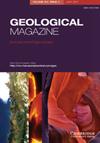Glacial sedimentation in Northern Gondwana: insights from the Talchir formation, Manendragarh, India
IF 2
3区 地球科学
Q3 GEOSCIENCES, MULTIDISCIPLINARY
引用次数: 0
Abstract
Abstract Among the vast swathes of Gondwanan sedimentary rocks in India, exposures of the Lower Permian Talchir Formation at Manendragarh in India are exceptional for their cold marine faunal assemblage and muddy conglomerates of possible glacial origin. They may represent a record of the late Palaeozoic glaciation that affected Gondwana in the Permo-Carboniferous. Although the fossil record is relatively well documented, the sedimentology of this area is not well understood. This paper intends to fill the gap in knowledge regarding palaeogeography and the palaeoenvironmental changes within the basin through space and time. We distinguish conglomerates that are formed by glacial and mass flow processes. The lateral variation in facies associations along a NNE-SSW transect in the study area identifies the depositional basin as an interior sea that formed when the sea spilled over a steep basement ridge during a transgression. The benthic organisms remained confined to the seaward basin margin where they only flourished in the initial stage of basin filling. Locally derived, bioclastic storm beds are limited to the seaward flank of the basin. Alternating phases of glaciation and interglaciation resulted in an interbedded succession of grey shales and interglacial density flow deposits. The channels that fed these density flows are preserved closest to the landward margin of the basin. Co-existence of glacial diamictites and interglacial density flow deposits highlights the climatic changes in this part of Gondwana during the Late Palaeozoic.冈瓦纳北部的冰川沉积:来自印度马南德拉加尔Talchir地层的见解
摘要在印度广大的冈瓦纳大陆沉积岩中,位于印度Manendragarh的下二叠统Talchir组的暴露是其寒冷的海洋动物群和可能起源于冰川的泥质砾岩的例外。它们可能代表了影响石炭-二叠纪冈瓦纳大陆的晚古生代冰川作用的记录。尽管化石记录相对完整,但该地区的沉积学还不太清楚。本文旨在填补有关古地理和盆地内古环境时空变化的知识空白。我们区分了由冰川和物质流过程形成的砾岩。研究区沿NNE-SSW样带的相组合的横向变化将沉积盆地确定为海侵期间海水溢出陡峭的基底山脊时形成的内海。底栖生物仍然局限于向海的盆地边缘,在那里它们只在盆地填充的初始阶段蓬勃发展。局部衍生的生物碎屑风暴床仅限于盆地的向海侧。冰川作用和间冰川作用的交替阶段导致了灰色页岩和间冰川密度流沉积的互层序列。供给这些密度流的通道被保存在最靠近盆地陆地边缘的地方。冰川杂岩和间冰川密度流沉积物的共同存在突出了晚古生代冈瓦纳大陆这一地区的气候变化。
本文章由计算机程序翻译,如有差异,请以英文原文为准。
求助全文
约1分钟内获得全文
求助全文
来源期刊

Geological Magazine
地学-地球科学综合
CiteScore
4.70
自引率
0.00%
发文量
111
审稿时长
3 months
期刊介绍:
Geological Magazine, established in 1864, is one of the oldest and best-known periodicals in earth sciences. It publishes original scientific papers covering the complete spectrum of geological topics, with high quality illustrations. Its worldwide circulation and high production values, combined with Rapid Communications and Book Review sections keep the journal at the forefront of the field.
This journal is included in the Cambridge Journals open access initiative, Cambridge Open Option.
 求助内容:
求助内容: 应助结果提醒方式:
应助结果提醒方式:


